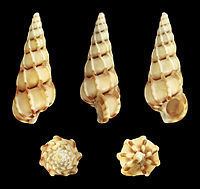Kingdom Animalia Family Epitoniidae Scientific name Epitonium clathrum Higher classification Epitonium | Superfamily Epitonioidea Genus Epitonium Phylum Mollusca Rank Species | |
 | ||
Similar Epitonium, Gastropods, Wentletrap, Molluscs, Euspira nitida | ||
Epitonium clathrum, common name the common wentletrap, is a species of small predatory sea snail, a marine gastropod mollusc in the family Epitoniidae, the wentletraps.
Contents
The spelling Epitonium clathrus is adopted by the World Register of Marine Species (WoRMS)
Synonyms
Originally described by Linnaeus as Turbo clathrus, it was later known as Clathrus clathrus, Scalaria communis Lamarck, 1822 and Epitonium commune
Distribution
The Common Wentletrap is very common along the eastern Atlantic coast, in the North Sea up to Norway, the Mediterranean and the Black Sea. Live specimens have only rarely be observed While it does occur in the Baltic Sea, it has become a vulnerable species there.
Feeding habits
Epitonium clathrum is a predator of sea anemones (Anthozoa, Actiniaria) and corals (Anthozoa, Scleractinia). It has been seen feeding on the sea anemone Anemonia sulcata and found in the neighbourhood of sea anemones Sagartia troglodytes and Sargartiogeton undatus
Description
Shell : The cone-shaped shell reaches a height of 35 mm. It is shiny white to cream-coloured, often with brown spots, Seven thick and very distinct costae (spiral ribs) wind around twelve to fifteen whorls. These convex whorls often contain two or three purple bands that can best seen when they cross the lamella of the outer lip. The protoconch is usually blunt. The aperture is entire and rounded. Its top coincides with a suture. The umbilicus is lacking. The operculum is horny and paucispiral.
Soft parts (data compiled from Tryon (1887) and Thiele (1929): The short foot is truncated in front and extends far in advance of the head. The long tentacles are narrow and close together. The eyes are situated on the base of the tentacles. The mantle margin is simple and contains a rudimentary siphonal fold. The radula is wide and more or less bent at the end. The radular teeth are elongate and hook-shaped or needle-shaped,with many teeth in a series. The species is hermaphroditic.
